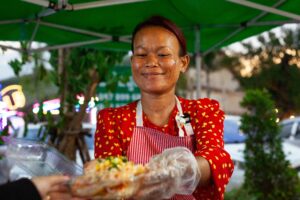Essential Dishes, Flavors, and Food Culture
Cambodian cuisine, also known as Khmer cuisine, is a fascinating blend of flavors influenced by neighboring Thailand and Vietnam, with roots reaching back thousands of years. Known for its delicate balance of sweet, sour, salty, and bitter tastes, Cambodian food offers tourists an authentic and flavorful experience. In this guide, we’ll explore some of the most iconic Cambodian dishes, popular street food, dining customs, and tips for enjoying Khmer cuisine to the fullest.

Understanding Cambodian Cuisine
Cambodian cuisine uses a combination of fresh herbs, spices, and locally sourced ingredients that result in unique flavors. Common ingredients include lemongrass, kaffir lime, galangal, fish sauce, and prahok—a fermented fish paste that adds a strong, distinctive flavor to many dishes.
Cambodian food is often less spicy than Thai cuisine, making it approachable for most palates, but it offers plenty of depth and complexity. Khmer food often combines influences from India and China, with an emphasis on rice, noodles, and fresh vegetables, as well as an array of fresh herbs.
Must-Try Cambodian Dishes
If you’re visiting Cambodia, here are some of the essential dishes you should try:
- Amok Trey (Fish Amok): Cambodia’s national dish, fish amok is a mild and fragrant curry made with freshwater fish, coconut milk, and kroeung (a spice paste made of lemongrass, kaffir lime leaves, turmeric, and other herbs). It’s typically steamed in banana leaves, giving it a smooth, mousse-like texture.
- Samlor Korkor: Often referred to as Cambodia’s “national soup,” this dish is a thick, nutritious vegetable soup with kroeung, fish or meat, and a mix of local vegetables like green papaya and long beans. It’s a comforting and flavorful option for those seeking a traditional Cambodian taste.
- Bai Sach Chrouk (Grilled Pork with Rice): This is a popular breakfast dish featuring marinated, slow-grilled pork served over rice, usually accompanied by pickled vegetables and a light, tangy fish sauce dressing. It’s a simple but flavorful meal that’s popular with locals and tourists alike.
- Nom Banh Chok (Khmer Noodles): Known as “Khmer noodles,” this breakfast staple consists of rice noodles topped with a green fish gravy made from lemongrass and other herbs, garnished with fresh vegetables, banana flower, and herbs. Street vendors often sell this dish in the mornings.
- Lok Lak: A stir-fried beef dish, Lok Lak is often served with rice or on a bed of lettuce, tomatoes, and cucumbers. The meat is marinated in a mix of soy sauce, oyster sauce, and lime juice, and it’s usually accompanied by a dipping sauce made from lime, pepper, and salt.
- Prahok Ktiss: This is a popular dip made from minced pork and prahok (fermented fish paste) mixed with coconut milk, chili, and lime leaves. Prahok Ktiss is typically served with fresh vegetables for dipping and has a strong, savory taste.

Cambodian Street Food
Cambodian street food is vibrant, diverse, and offers a taste of the country’s culinary creativity. From quick snacks to satisfying meals, here are some street food items worth sampling:
- Num Pang (Cambodian Baguette Sandwich): Influenced by the French colonial period, Num Pang is a baguette sandwich filled with pork, pâté, pickled vegetables, herbs, and chili sauce. It’s similar to a Vietnamese Banh Mi but has its own unique Cambodian twist.
- Chive Cakes (Num Kachay): These savory rice flour cakes are mixed with chives, pan-fried, and served with a sweet and sour dipping sauce. They’re crispy on the outside and soft on the inside, making for a delicious snack.
- Grilled Skewers: Meat skewers, including beef, pork, and chicken, are marinated in spices and grilled over open flames. They’re affordable and perfect for on-the-go snacking.
- Insects: For the adventurous, Cambodian street food offers various fried insects, including crickets, tarantulas, and silkworms. They’re high in protein and considered a delicacy by many locals.
- Fried Banana (Chek Chien): A popular Cambodian dessert, fried banana slices are coated in a light batter and fried until crispy. It’s a sweet and satisfying treat commonly found at street stalls.

Dining Etiquette and Food Culture in Cambodia
Understanding Cambodian dining etiquette can enhance your experience and show respect for local customs. Here are some key tips:
- Family Style Dining: Meals are typically served family-style with various dishes placed in the center. It’s customary to try a bit of everything, so don’t hesitate to sample multiple dishes.
- Respect for Food: Food is highly valued in Cambodian culture, and wasting food is considered disrespectful. Only take as much as you can eat.
- Chopsticks and Spoons: In many places, you’ll be given chopsticks for noodles and a spoon and fork for other dishes. Cambodians traditionally use the spoon to eat, with the fork serving to push food onto the spoon.
- Waiting to Eat: Wait until the oldest person at the table starts eating before you begin, as a sign of respect.

Popular Cambodian Drinks and Desserts
Cambodian cuisine also includes unique drinks and desserts that are worth trying:
- Sugarcane Juice (Tek Doh Khnor): This refreshing juice is made from fresh sugarcane pressed with ice and sometimes lime. It’s a popular street drink, especially in hot weather.
- Iced Coffee (Kafe Tuk Ko): Cambodia’s iced coffee is strong, sweet, and often served with condensed milk. It’s perfect for coffee lovers seeking a refreshing pick-me-up.
- Coconut Milk Desserts: Many Cambodian desserts, or “Nom,” are made with coconut milk, rice flour, and tropical fruits. Try treats like Num Plae Ai (rice dumplings with palm sugar filling) or Num Ansom Chek (sticky rice with banana filling wrapped in banana leaves).
- Fruit Shakes: Fresh fruit shakes are widely available, using ingredients like mango, pineapple, dragon fruit, and banana. They’re refreshing and a great way to cool down.
Health and Safety Tips for Eating in Cambodia
While Cambodian food is generally safe and delicious, here are some tips for a comfortable culinary experience:
- Drink Bottled Water: Tap water isn’t safe to drink in Cambodia, so opt for bottled water or ask for no ice in your drinks unless you’re sure it’s made from purified water.
- Choose Busy Food Stalls: Popular food stalls with high turnover tend to have fresher food. Look for places where locals gather to ensure food safety.
- Carry Hand Sanitizer: Hygiene standards may vary, so it’s wise to use hand sanitizer before meals.
- Be Cautious with Spices: Cambodian food isn’t as spicy as Thai food, but certain dishes can pack a punch. Start with mild dishes if you’re sensitive to spice.
Final Thoughts: Savoring Cambodian Cuisine
Cambodian cuisine is diverse, flavorful, and deeply rooted in tradition. From iconic dishes like fish amok and lok lak to adventurous street food and refreshing desserts, there’s something for every palate. As you explore Cambodia’s temples and landscapes, make sure to dive into its culinary world as well. By embracing the flavors and dining customs of Khmer cuisine, you’ll gain a richer understanding of Cambodia’s culture and enjoy an unforgettable food journey.
